With the 2024 Election rapidly approaching, we thought a brief update to remind friends of The Prudent Speculator to look far down the path would be useful.
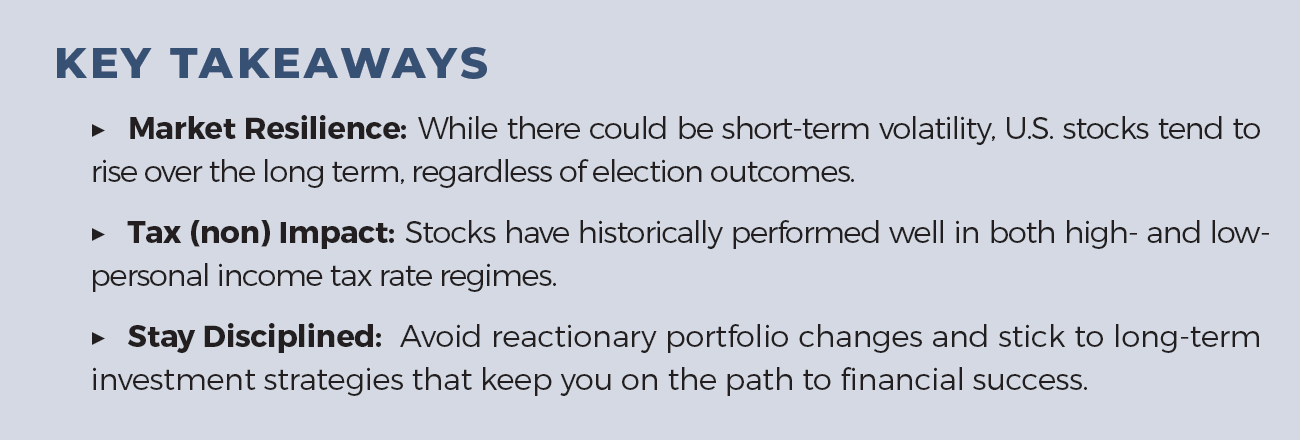
Our first Special Report on the upcoming election, Market Insights for the 2024 Presidential Election (click here), offered a 35,000-foot view of presidencies, congress and stock market history reaching back nearly a century. The second report, Thoughts on Stocks for the 2024 Election (click here), covered returns for Trump and Biden, candidate policy proposals, tax policies and several dozen stock picks, including small-caps. With just a few days until November 5 and with election fatigue at maximum levels, we thought a brief update to remind friends of The Prudent Speculator to look far down the path would be useful.
Figure 1 shows betting odds for a race that is still too close to call. With many votes already counted and votes streaming in, we offer the reminder that the major equity indexes are trading near all-time highs, illustrating that markets have managed to move higher over the long term whether a Democrat or Republican occupies the Oval Office and/or controls Congress. Of course, individual stocks could be impacted by a President Trump or President Harris administration, but we continue to warn that the outcome of the election is unlikely to derail a purposefully designed asset allocation from achieving long-term financial goals. Indeed, avoiding the urge to tinker with said allocation or portfolio can go a long way in keeping you pointed in the direction.
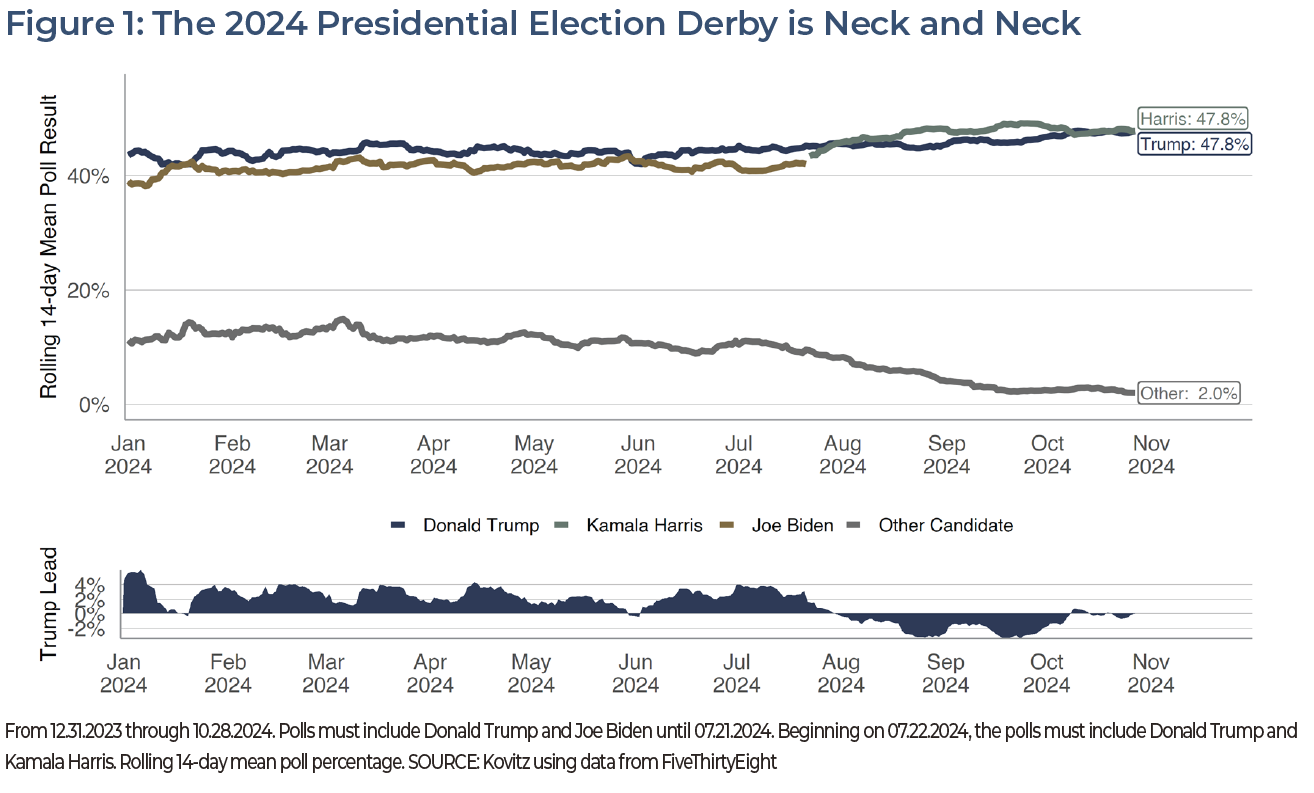
PAST PERFORMANCE
We shared Figure 2 in the second Special Report and updated it for this Insight. When we originally ran the numbers, we expected certain outcomes based on our recollection of the past. Standing out in our minds was Trump’s pro-Energy stance. Notably, shareholders didn’t seem to benefit from that policy change. And Mr. Biden’s drilling limits and EV initiatives hardly harmed returns. Perhaps, it’s been an extraordinary period. Certainly, we can’t skip the pandemic, which made things worse, but the sector had been hit hard before COVID-19.
And then there was the Tech-fueled rally coming out of the pandemic. While hotels, restaurants and airlines were struggling, companies rapidly deployed work-from-home technology, pivoted to video streaming and extra bedroom demand spiked. Tech stocks soared and that continued with Biden. How easy it is to mentally erase the 28.2% drop for the sector in 2022, even as the ensuing gain of 110.2% since has been terrific. Still, Trump Tech performance beats the Biden return. The point of this quick trip down memory lane is not to instill anger, fear or any emotion. Instead, we offer Figure 2 to show that returns over the last two presidencies simply may not align with recent memory for many.
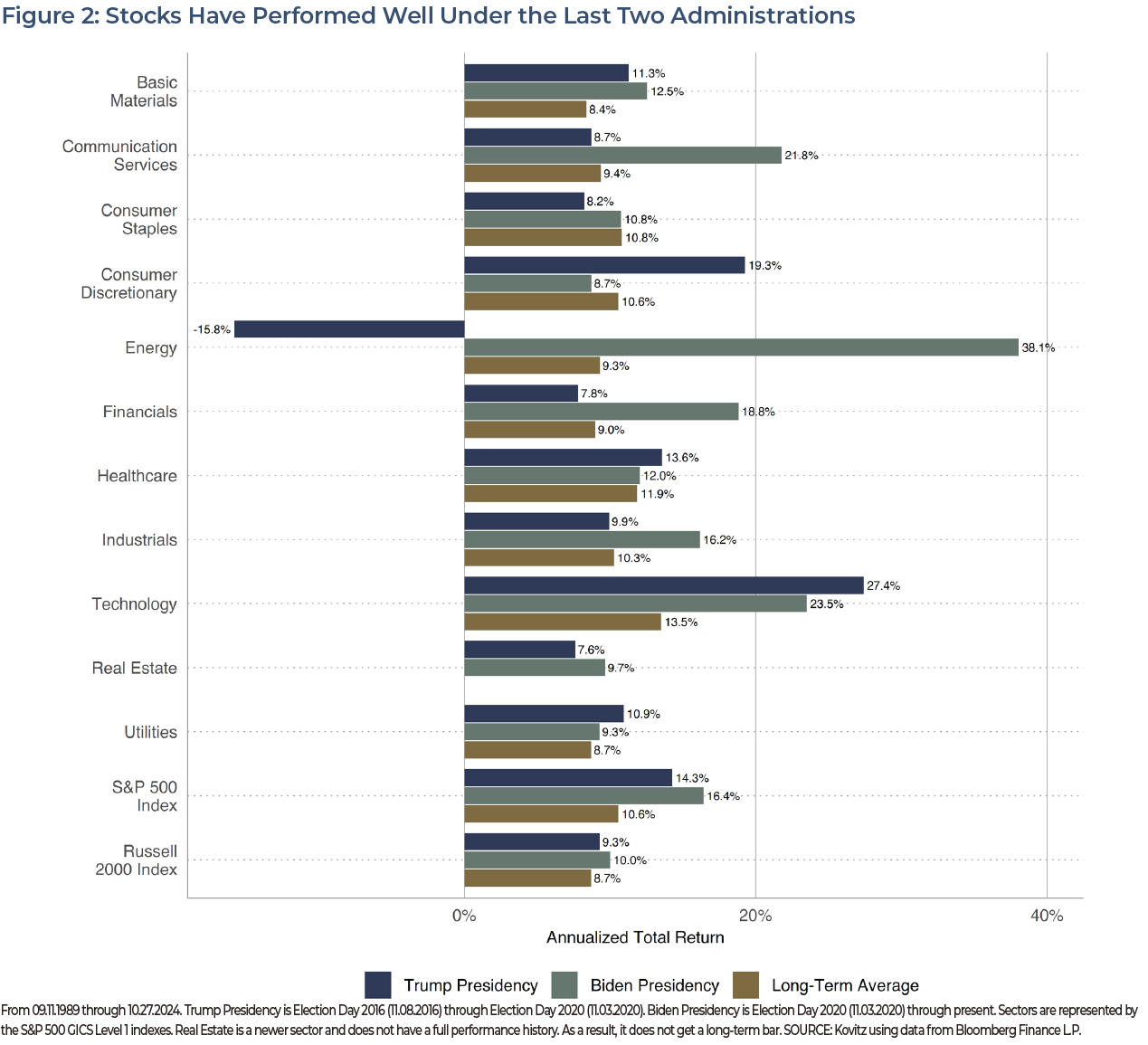
RETURNS BY PRESIDENT
Presidential terms for Herbert Hoover, Franklin D. Roosevelt (Term 2) and George W. Bush (Term 2) are the only three instances since 1928 where Value stocks posted negative returns. Large Company Stocks (the S&P 500) show a similar trend with the inclusion of a -2.1% S&P 500 return for George W.’s first term. Hoover and Bush were Republicans, while Roosevelt was a three-term Democrat. It’s hard to say that means anything though—the president or the party— because there are other reasons to explain the investment returns that do not directly involve the sitting president.
For example, in 1932, the U.S. was in the midst of the Great Depression. Roosevelt’s second term included World War II, while George W.’s first term included the terrorist attacks on September 11 and the second term included the Great Financial Crisis. On the bond side, all returns have been positive, even if only modestly so, except for two. In the early 1980’s, Federal Reserve Chair Paul Volcker took a 2×4 to inflation, which resulted in losses for bond investors. Similar interest rate action caused monster losses for long-term bond investors coming out of the COVID-19 pandemic. We suspect we could work through each president’s positive returns, too, and come up with an apolitical explanation for success, perhaps more than one.
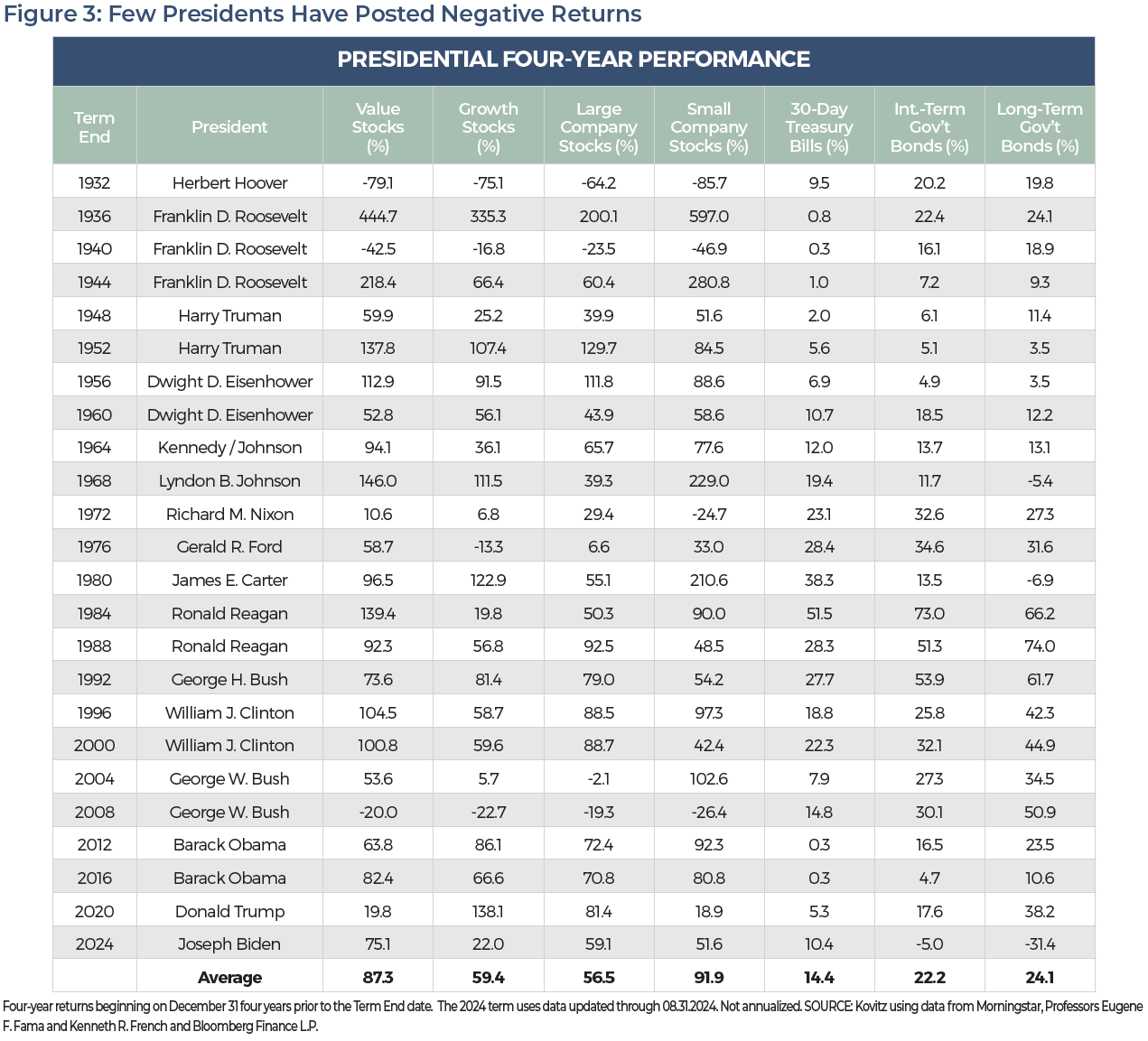
RETURNS BY CONGRESS
Perhaps Congress is more impactful, at least when it comes to investment returns? Actually, Figures 4 and 5 show a pronounced trend based on the composition of Congress. The charts are dramatic, with the message practically jumping off this paper that equity investors should cheer loudly when Democrats are fully in the driver’s seat of the U.S. government and bond investors should cheer equally loudly when the U.S. has a Republican president with a split Congress. Not so fast. The underlying data shows the trends are not very robust.
There are only three two-year periods with a Republican in the White House and a split Congress. Even though we’ve crunched almost 100 years of data to create the chart, which is a substantial time window, it seems perilous–or even reckless–to change an investment allocation based on just six of those years. A somewhat more robust conclusion would be to invest when the Democrats are in full control since there are 34 years of investment data under that setup, but we are not at all convinced that means we should dump our stocks and bonds when the Democrats are not in control.
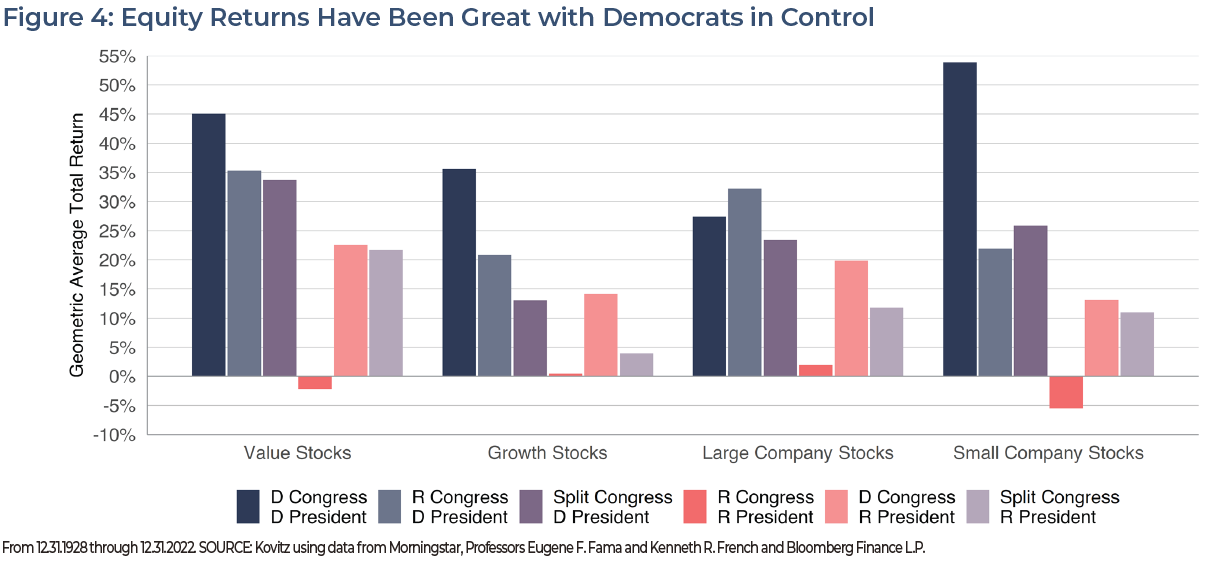
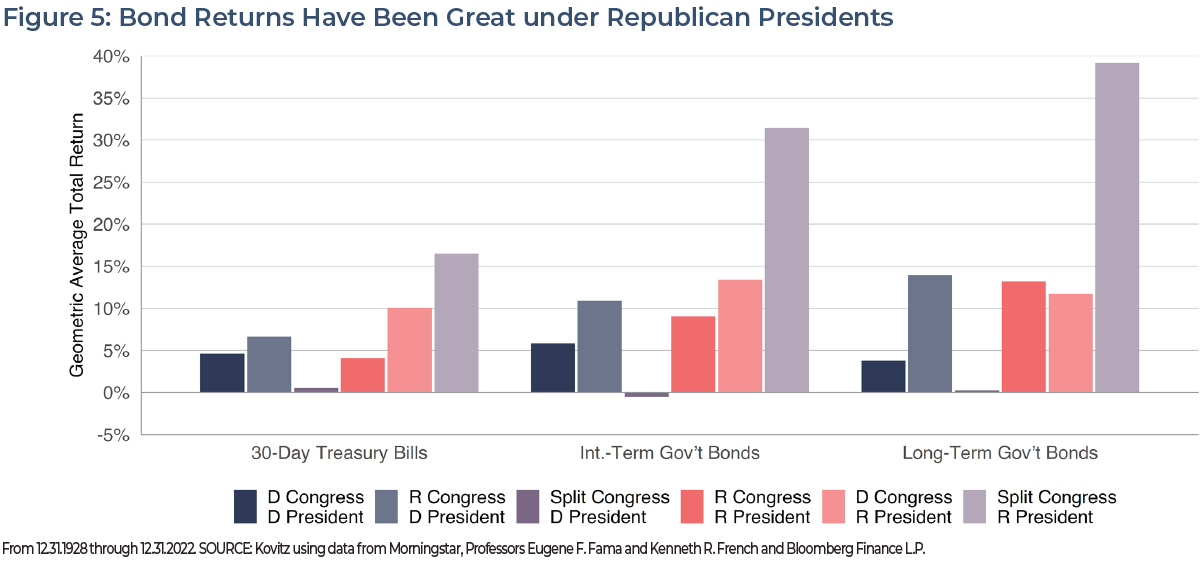
TAX POLICY IN FOCUS IN THE 2024 ELECTION, 2025 AND BEYOND
Thoughts on Stocks for the 2024 Election (click here) offered a lot more detail on this topic than we have space for in this Insight, but a high-level review is in order, as we suspect the often-polarizing topic of taxation is a very most important –and potentially worrying– issue on the mind of most investors.
Former President Trump has indicated that he plans to make personal tax changes in the 2017 Tax Cuts and Jobs Act (TCJA) permanent. Additionally, he wrote in September on his Truth Social platform that he will “get SALT back,” a reference to the $10,000 cap on state and local taxes imposed by the TCJA. On Trump’s campaign website, the platform does not mention personal taxes, except for “large tax cuts for workers and no tax on tips,” and otherwise offers little detail.
In addition to the potential personal income tax changes, Vice President Harris has proposed an increase of the corporate tax rate from 21% to 28%. Additionally, she is proposing a share buyback tax hike from 1% to 4%. Trump has not yet formally proposed corporate tax policy plans, but he has indicated that he would consider extending the TCJA, reducing the corporate tax rate by 1% to 20% and/or trimming corporate income tax rates for U.S. producers to 15%.
Although both tax regimes could have definite impacts on corporate profits for our newsletter recommendations, it’s unlikely that the impact would be felt uniformly. Of course, the bean counters will always endeavor to find loopholes, workarounds and creative solutions to mitigate Corporate America’s tax bill. Such has been the case since 1909, the first year Uncle Sam imposed a separate corporate income tax as few businesses pay the maximum corporate income tax rate, given deductions, exemptions, credits and other legal factors.
HIGHER TAXES ARE BAD GOOD FOR STOCKS
When it comes to taxes, this election is no different than those in the past as numerous stories portend gloom and doom for equities if taxes are raised and unicorns and rainbows should taxes be reduced. On the surface, the logic would appear sound. Who wouldn’t be in a better mood if they kept more of what they earned, and wouldn’t an investor have less incentive to participate in the capital markets if their overall tax bill was higher?
We analyzed the returns for individual high-tax regimes (above 39.6% top rate) and low-tax regimes (39.6% and below) over the last 97 years and determined that stocks perform fine on both counts, BUT they have performed better on average when taxes are…drumroll, please…HIGH! There were 55 “High Rate” regimes and 42 “Low-Rate” regimes since 1927, which doesn’t exactly paint the picture of a skewed dataset, but major unrelated market events make the findings less useful.
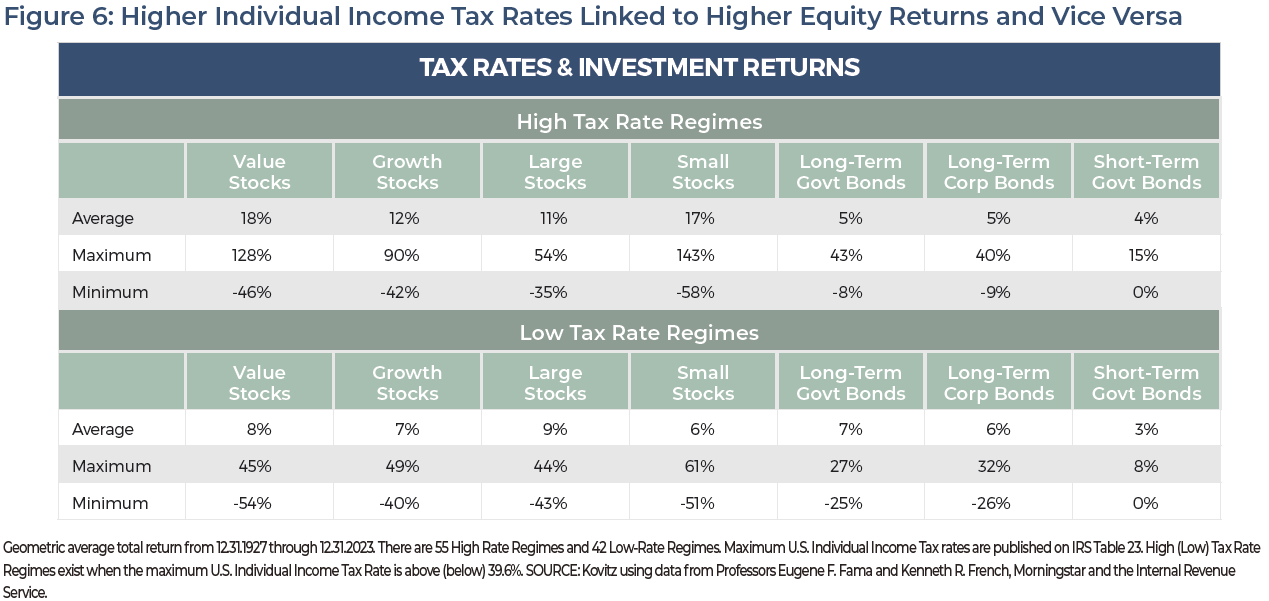
DON’T MOVE AHEAD OF THE 2024 ELECTION
No doubt, it’s tempting to want to use political statements from “our” candidates (or those on the “other” side) as catalysts that necessitate action in a stock portfolio. After all, some would argue that you can zig or you can zag, but if you just stand there, you’re going to get run over.
We believe the election outcome –whatever it ends up being– is not a singular reason to make broad portfolio changes. In the two Special Reports and in the figures above, we have crunched nearly 100 years of data from multiple sources which all end up saying the same thing: trading in and out of stocks based on the resident of the Oval Office is likely to be deleterious to your wealth.
After the last election (and also in 2016), Google searches for “How to move to Canada” spiked. No doubt, the emotional reaction is natural, but actually doing that is complicated, time-consuming and unlikely to end up happening after cooler heads prevail. But it feels good and that’s what matters. It’s dangerous, in some ways, that selling stocks would be even easier than a move to Canada. Not only would a sale be likely to trigger a tax bill, it would also require a decision on when to get reinvested (probably not an about face the next day).
To calculate the potential damage from such frustration, we zeroed out returns for the “other” party and ran returns for the Large Company Stocks (S&P 500 index) series. An investor who refused to own stocks during a Republican presidency would have earned an annualized total return of 7.4% and an investor who refused to own stocks during a Democratic presidency would have earned an annualized 2.5%. Both figures fall massively short of the total return for the entire period of 10.1% for the permanently invested index.
VOTE IN THE 2024 ELECTION, BUT NOT WITH YOUR PORTFOLIO
We freely acknowledge that both candidates have proposed policies that could be good for our stocks. Also, both candidates have proposed policies that could be bad for our stocks. During election seasons, investors are often their own worst enemies considering progress towards their long-term financial goals. We offer a cautious reminder that what is repeated on the campaign trail doesn’t always make it through Capitol Hill and end up as policy.
As voters head to the polls in November, The Prudent Speculator will be riding through its 12th presidential election since 1977. In each case, the stakes were high and the sun came up for the world (and for our stocks) the following day. As is our custom, we simply remain partial to our approach of buying undervalued stocks and patiently holding them for the long term, trimming and harvesting the winners and pruning the losers along the way. It makes for peaceful slumber!
LEARN MORE
If you’d like additional information about The Prudent Speculator and Kovitz, kindly reach out to Jason R. Clark, CFA at 949.424.1013 or jclark@kovitz.com.





